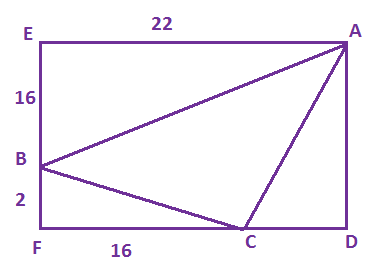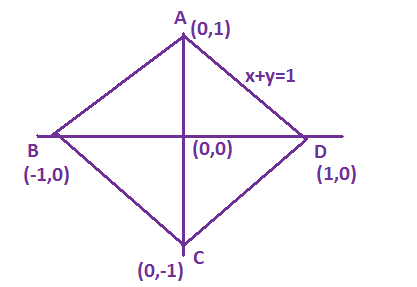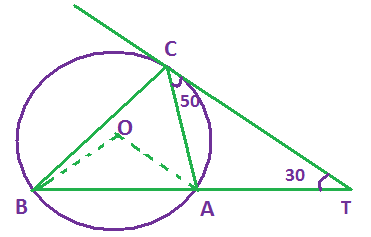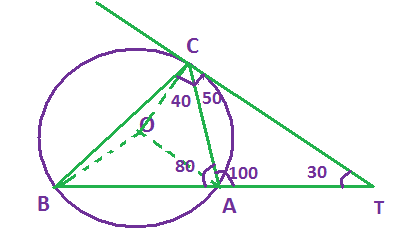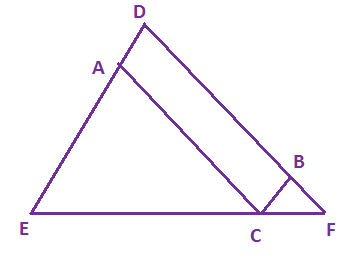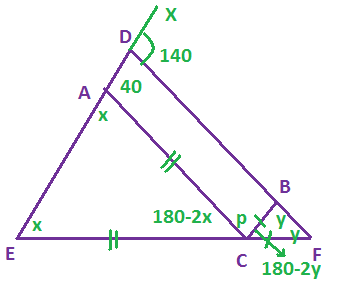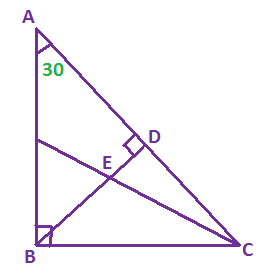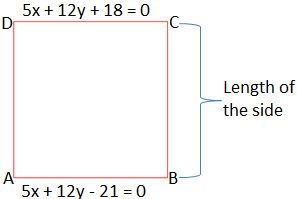Exams > Cat > Quantitaitve Aptitude
GEOMETRY SET I MCQs
Total Questions : 110
| Page 2 of 11 pages
Answer: Option A. -> 1
:
A
(a,b) If L=M, then L2 = LM or ML = M2
Both LM = ML = 1 as sec2A - tan2A = 1
∴L2 = M2 = 1.
:
A
(a,b) If L=M, then L2 = LM or ML = M2
Both LM = ML = 1 as sec2A - tan2A = 1
∴L2 = M2 = 1.
Answer: Option A. -> 1(a+b)3
:
A
(a) It is given that sin4Aa+cos4Ab=1a+b
⇒(1−cos2A)24a+(1+cos2A)24b=1a+b
⇒b(a+b)(1−2cos2A+cos22A)+a(a+b)(1+2cos2A+cos22A)=4ab
⇒{b(a+b)+a(a+b)}cos22A+2(a+b)(a−b)cos2A
:
A
(a) It is given that sin4Aa+cos4Ab=1a+b
⇒(1−cos2A)24a+(1+cos2A)24b=1a+b
⇒b(a+b)(1−2cos2A+cos22A)+a(a+b)(1+2cos2A+cos22A)=4ab
⇒{b(a+b)+a(a+b)}cos22A+2(a+b)(a−b)cos2A
Answer: Option B. -> 5
:
B
Option (b)
EF = AD = 8
(EADF is a rectangle)
CD = (22 – 16) = 6
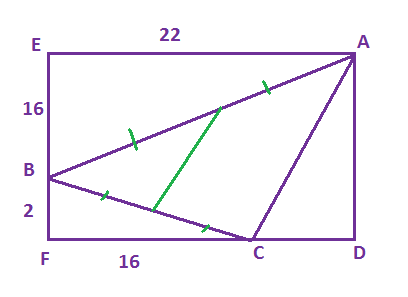
So in the right angled triangle ADC, AD = 8 and CD = 6.
Therefore AC = 10
Therefore length of the line joining the mid – points of
AB and BC = 12 (10) = 5
(length of the line joining the mid – point of two sides of a triangle is half the 3\(^{rd}\)
:
B
Option (b)
EF = AD = 8
(EADF is a rectangle)
CD = (22 – 16) = 6

So in the right angled triangle ADC, AD = 8 and CD = 6.
Therefore AC = 10
Therefore length of the line joining the mid – points of
AB and BC = 12 (10) = 5
(length of the line joining the mid – point of two sides of a triangle is half the 3\(^{rd}\)
Question 14. Answer the questions on the basis of the information given below :In the adjoining figure, I and II are circles with centers P and Q respectively. The two circles touch each other and have a common tangent that touches them at points R and S respectively. This common tangent meets the line joining P and Q at O. The diameters of I and II are in the ratio 4 : 3. It is also known that the length of PO is 28 cm.

What is the ratio of the length of PQ to that of QO? (2004)

What is the ratio of the length of PQ to that of QO? (2004)
Answer: Option B. -> 1:3
:
B
From the given diagram,
OQSQ=OPRP
OQOP=SQRP=34
Therefore, PQOQ=13
:
B
From the given diagram,
OQSQ=OPRP
OQOP=SQRP=34
Therefore, PQOQ=13
Answer: Option B. -> 60∘
:
B
∠ACB= 60
∠DCE= ∠ECB= 30
Therefore, ∠CED= 60. Option (b)
:
B
∠ACB= 60
∠DCE= ∠ECB= 30
Therefore, ∠CED= 60. Option (b)
Answer: Option D. -> 21 .5
:
D
1st method: - The simplest way to find this is to put a rectangle around the given quadrilateral and then subtract off the areas of the right triangles that surround it. (See Figure) The area of the entire rectangle is 40, but after subtracting the areas of the 4 right triangles, whose areas are 52, 4, 9 and 3. we are left with an area of 21.5.
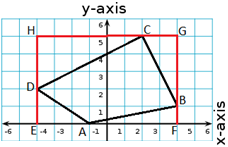
2nd method: - Area of quadrilateral = 2(x1y2−x2y1)+(x2y3−x3y2)+(x3y4−x4y3)+(x4y1−x1y4)
=12(−4×0−(−1)×2)+(−1×1−4×0)+(4×5−2×1)+(2×2−(−4)×5)=21.5
:
D
1st method: - The simplest way to find this is to put a rectangle around the given quadrilateral and then subtract off the areas of the right triangles that surround it. (See Figure) The area of the entire rectangle is 40, but after subtracting the areas of the 4 right triangles, whose areas are 52, 4, 9 and 3. we are left with an area of 21.5.

2nd method: - Area of quadrilateral = 2(x1y2−x2y1)+(x2y3−x3y2)+(x3y4−x4y3)+(x4y1−x1y4)
=12(−4×0−(−1)×2)+(−1×1−4×0)+(4×5−2×1)+(2×2−(−4)×5)=21.5

